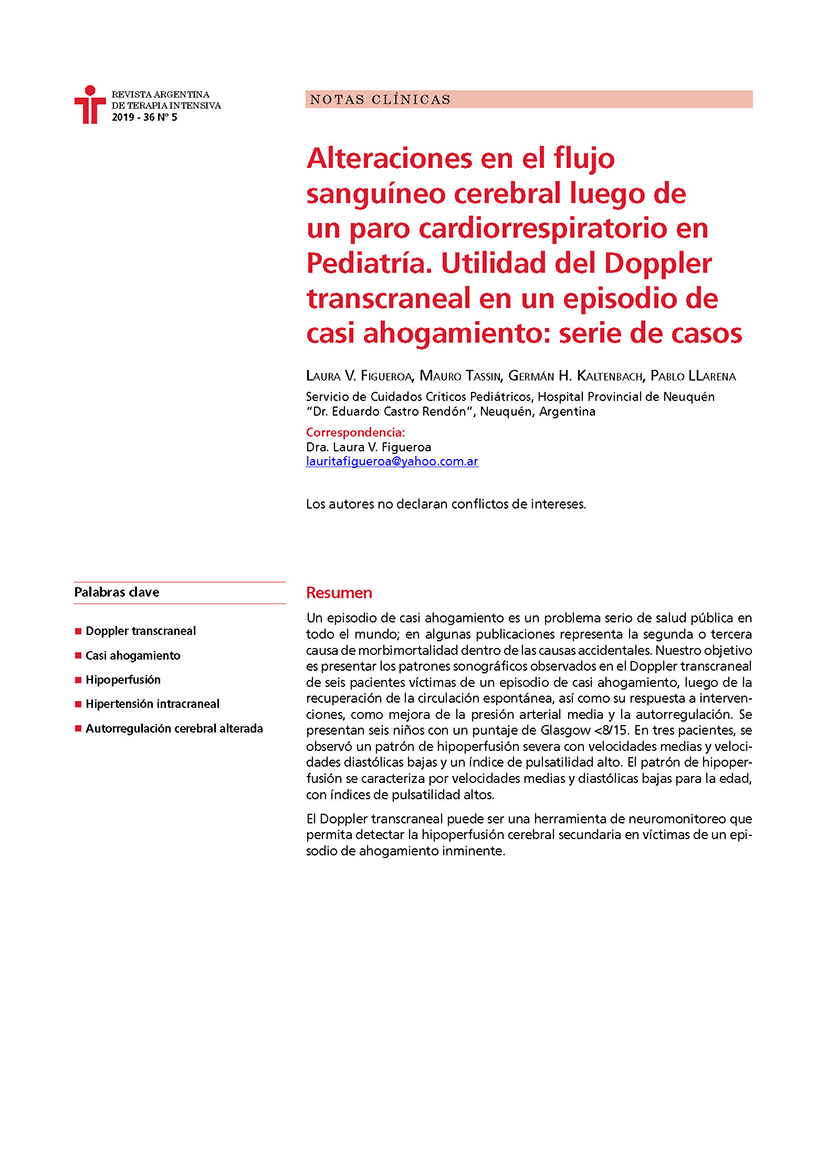Alteraciones en el flujo sanguíneo cerebral luego de la parada cardiorespiratoria pediátrica. Utilidad del doppler transcraneal en casi ahogamiento. Serie de casos.
Main Article Content
Abstract
El casi ahogamiento es un problema serio de salud pública en todo el mundo, siendo en algunos casos la segunda o tercera causa de morbimortalidad dentro de las causas accidentales
Nuestro objetivo es presentar los patrones sonográficos observados en el doppler transcraneal de 6 pacientes victimas de casi ahogamiento luego de la recuperación de la circulación espontánea, así como su respuesta a intervenciones como mejora de tensión arterial media y autorregulación.
Se presentan 6 pacientes pediátricos con Glasgow menor de 8/15.
En 3 pacientes se observó un patrón de hipoperfusión severa con Velocidades medias y Velocidades Diastólicas bajas e Índice de Pulsatilidad (IP) alto. El patrón de hipoperfusión se caracteriza por velocidades medias y velocidades diastólicas bajas para la edad, con IP altos.
El doppler transcraneal, puede ser una herramienta de neuromonitoreo que permita detectar la hipoperfusión cerebral secundaria en victimas de casi ahogamiento.
Article Details
The magazine does not retain the reproduction rights (copyright) so the authors can republish their works with the sole mention of the original publication source.
References
Moon RE, Long RJ. Drowning and near-drowning. Emerg Med Emerg 2002;14(4):377-86.
Burdford AE, Ryan LM, Stone BJ, Hirshon JM, Klein BL. Drowning and near-drowning in children and adolescents. Pediatr Emerg Care. 2005; 21:610-6.
Conn AW, Edmons JF, Barrer JA. Reanimación cerebral en el casi ahogamiento. Clin Pediatr North Am (ed esp). 1979;3:687-97.
Lordanova B., Li, L., Clark, R. S. B., Manole, M. D. (2017). Alterations in Cerebral Blood Flow after Resuscitation from Cardiac Arrest. Frontiers in Pediatrics.
MartÃnez De Azagra, A, Jiménez, R. (2004). Utilidad del Doppler transcraneal. Anales de PediatrÃa Continuada.
Bode H, Wais U: Age dependence of Ilow velocities in basal cerebral arteries, Arch Dis Child 63:606-611, 1988.
Fiser DH. Assessing the outcome of pediatric intensive care. J Pediatr 1992; 121(1):68-74.
J.P. Nolan, R.W. Neumar, C. Adrie, M. Aibiki, R.A. Berg, B.W. Böttiger Post-cardiac arrest syndrome: Epidemiology, pathophysiology, treatment, and prognostication. A Scientific Statement from the International Liaison Committee on Resuscitation; the American Heart Association Emergency Cardiovascular Care Committee; the Council on Cardiovascular Surgery and Anesthesia; the Council on Cardiopulmonary, Perioperative, and Critical Care; the Council on Clinical Cardiology; the Council on Stroke Resuscitation, 79 (2008), pp. 350-379.
V. Lemiale, O. Huet, B. Vigué, A. Mathonnet, C. Spaulding, J.P. Mira Changes in cerebral blood flow and oxygen extraction during post-resuscitation syndrome. Resuscitation, 76 (2008), pp. 17-24
Ãlvarez-Fernández JA, M.M.MartÃn-Velascob MM, Igeñoo-Canob J.C., Pérez-Quintero, R. Utilidad del Doppler transcraneal en la resucitación de la parada cardÃaca. Med Intensiva.2010;34(8):550–558
A.C. Nebra-Puertas, V. Virgós-Señor, M.A. Suárez-Pinilla, J. Munárriz-Hinojosa, R. Ridruejo-Sáez, J.I. Sánchez-Miret Modificaciones en la velocidad de flujo cerebral medidas mediante Doppler transcraneal, tras maniobras de soporte vital avanzado Med Intensiva, 27 (2003), pp. 219-223
V. Lemiale, O. Huet, B. Vigué, A. Mathonnet, C. Spaulding, J.P. Mira Changes in cerebral blood flow and oxygen extraction during post-resuscitation syndrome Resuscitation, 76 (2008), pp. 17-24
T. Wessels, J.U. Harrer, C. Jacke, U. Janssens, C. Klötzsch The prognostic value of early transcranial Doppler ultrasound following cardiopulmonary resuscitation Ultrasound Med Biol, 32 (2006), pp. 1845-1851
Lin, J.-J., Hsia, S.-H., Wang, H.-S., Chiang, M.-C., & Lin, K.-L. (2015). Transcranial Doppler ultrasound in therapeutic hypothermia for children after resuscitation. Resuscitation, 89, 182–187.
Sundgreen C, Larsen FS, Herzog TM, Knudsen GM, Boesgaard S, Aldershvile J. Autoregulation of cerebral blood flow in patients resuscitated from cardiac arrest. Stroke. 2001 Jan; 32(1):128–32.
Manole MD, Foley LM, Hitchens TK, Kochanek PM, Hickey RW, Bayir H, Alexander H, Ho C, Clark RS. Magnetic resonance imaging assessment of regional cerebral blood flow after asphyxia cardiac arrest in immature rats. J Cereb Blood Flow Metab. 2009 Jan; 29(1):197–205.
Bhate TD, et al. Association between blood pressure and outcomes in patients after cardiac arrest: A systematic review. Resuscitation (2015).

